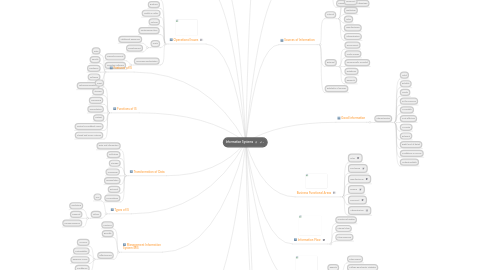
1. Ethical Issues
1.1. Codes of Practice
1.2. "Whistle-blowing"
1.3. Policies
1.4. Information Ownership
2. Operational Issues
2.1. Security
2.2. Backups
2.3. Health & Safety
2.4. Policies
2.5. Continuance Plans
2.6. Costs
2.6.1. Additional Resources
2.6.2. Development
2.7. Increasing Sophistation
2.7.1. Trained Personnel
2.7.2. Complex Software
3. Legal Issues
3.1. Data Protection 1998
3.2. Freedom of Inforamtion
3.3. ComputerMisuse Act 1990
4. Features of IS
4.1. Data
4.2. People
4.3. Hardware
4.4. Software
4.5. Telecommunications
5. Functions of IS
5.1. Input
5.2. Storage
5.3. Processing
5.4. Manipulation
5.5. Output
5.6. Control & Feedback Loops
5.7. Closed and Open Systems
6. Transformation of Data
6.1. Data and Inforamtion
6.2. Collection
6.3. Storage
6.4. Processing
6.5. Manipulation
6.6. Retrieval
6.7. Presentation
7. Types of IS
7.1. MIS
7.2. Others
7.2.1. Marketing
7.2.2. Financial
7.2.3. Human Resource
8. Management Information System MIS
8.1. Features
8.2. Benefits
8.3. Effectiveness
8.3.1. Accuracy
8.3.2. Sustainability
8.3.3. Response TImes
8.3.4. Confidence
9. Tools
9.1. Software
9.1.1. Databases
9.1.2. Artificial Intelligence
9.1.3. Expert Systems
9.1.4. Predictive Modelling
9.2. Internet
9.3. Data Mining Systems
10. Gather Information
10.1. Define Requirement
10.2. Establish Sources
10.3. Define other factors
10.4. Select Information
11. Types of Information
11.1. Qualitative
11.2. Qunatitative
11.3. Primary
11.4. Secondary
12. Purposes of Information
12.1. Operational Support
12.1.1. Monitoring
12.1.2. Controlling
12.2. Analysis
12.2.1. Identify Patterns
12.2.2. Decision Making
12.2.2.1. Operational
12.2.2.2. Tactical
12.2.2.3. Strategic
12.3. Gaining Commercial Advantage
13. Sources of Information
13.1. Internal
13.1.1. Financial
13.1.2. Personnel
13.1.3. Marketing
13.1.4. Sales
13.1.5. Manufacturing
13.1.6. Administration
13.2. External
13.2.1. Government
13.2.2. Trade Groups
13.2.3. Commercially Provided
13.2.4. Databases
13.2.5. Research
13.3. Reliability of Sources
14. Good Information
14.1. Characteristics
14.1.1. Valid
14.1.2. Reliable
14.1.3. Timely
14.1.4. Fit for Purpose
14.1.5. Accessible
14.1.6. Cost-effective
14.1.7. Accurate
14.1.8. Relevant
14.1.9. Right level of detail
14.1.10. Confidence in Source
14.1.11. Understandable
15. Business Functional Areas
15.1. Sales
15.2. Purchasing
15.3. Manufacturing
15.4. Finance
15.5. Personnel
15.6. Administration
16. Information Flow
16.1. To External Bodies
16.2. Internal Flow
16.3. Flow Diagrams
17. Analyse Information
17.1. Quality
17.1.1. Validity
17.1.2. Accuracy
17.1.3. Currency
17.1.4. Relevance
17.1.5. Identify Alternatives
18. MIS
18.1. Reports
18.1.1. Sales Report
18.1.2. College Enrolments Statistics
18.1.3. Marketing Analysis
